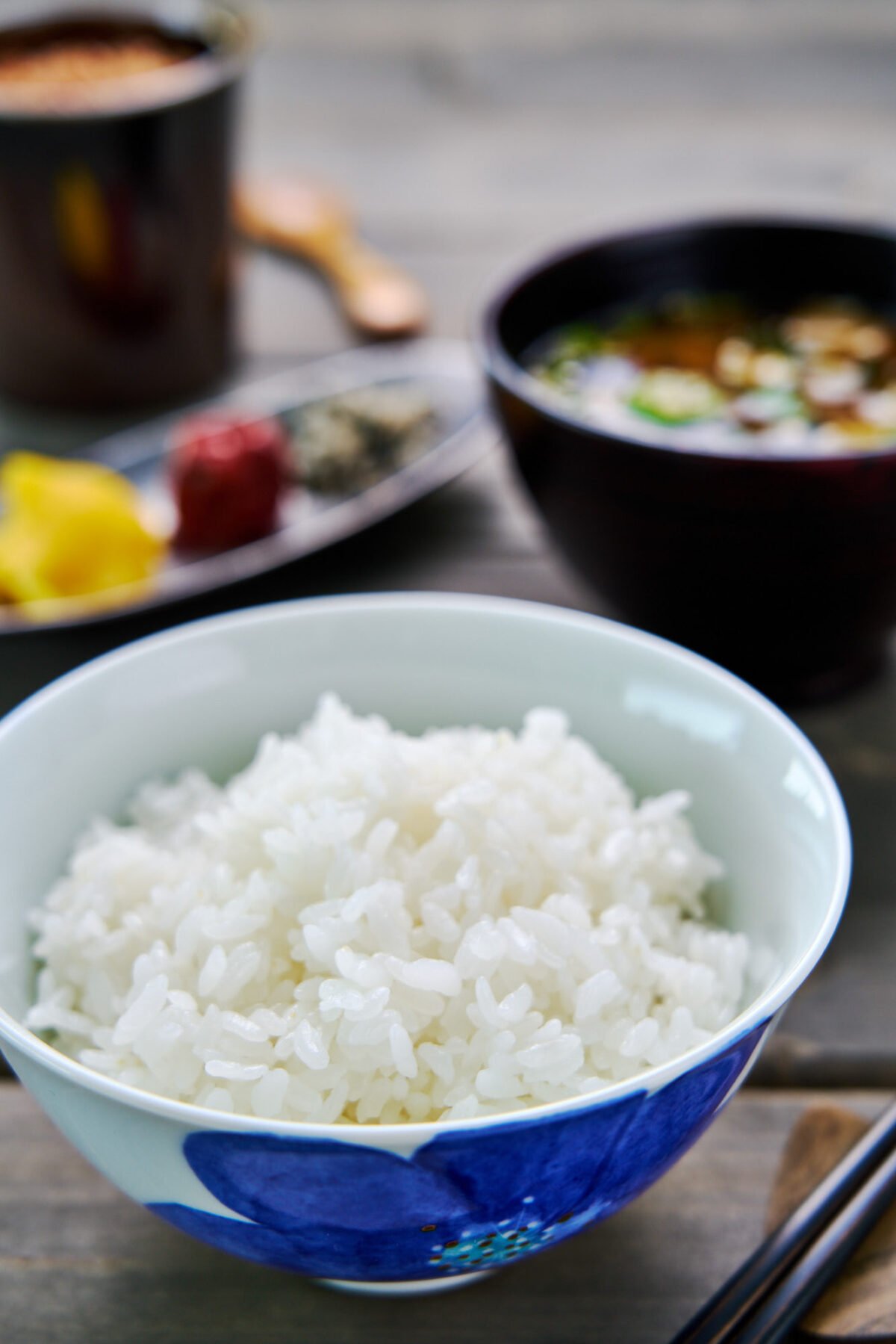
Short Grain Rice for Japanese Food
Here in Japan, rice is a staple of the Japanese diet, and it's one of the first things that kids learn how to cook. Most people use a rice cooker for cooking rice these days, but in this tutorial, I want to show you a foolproof traditional method for making rice on the stove. I'm also going to demystify the types of Japanese short-grain rice and common labels and brands to help you pick the right one in the store.
Jump to:
Why This Recipe Works
- The milling process leaves some powdered starch on the surface of the rice. If you don't rinse this off, the water will quickly thicken when heated, making it harder for the rice to absorb.
- Because short-grain rice is not boiled like pasta, the ratio of rice to water is extremely important. I recommend measuring the rice and water using either cups or a scale.
- Like most dried foods, rice cooks through more evenly if you soak it in water first to rehydrate it. In this short grain rice recipe I recommend soaking it for at least 30 minutes before cooking it.
- By simmering the rice over low heat for 10 minutes and then letting it steam off the heat for 10 minutes, you will end up with perfectly cooked rice.
Common Mistakes
- Please don't use your finger to measure the water. Many Asian grandmas will tell you to measure the amount of water you cook the rice in with your finger, but I do not recommend this method. Someone who's been cooking rice for years in the same pot using the same finger has figured out exactly where on their finger to measure the rice and water to. But the length of everyone's finger is different, and since a pot's diameter affects the depth of the same amount of water, this is not a good method to start out with. Using a measuring cup or scale ensures you have the right rice to water ratio so your rice cooks up consistently every time, no matter what pot or whose finger is involved.
- Don't open the lid. Once you start cooking the rice, you don't want to open the lid until it's done steaming. Opening the pot allows the gathered steam to escape. This lowers the temperature and reduces the amount of water for the rice to absorb as it cooks. I recommend using a glass lid so that you can see what's going on inside the pot. If you don't have a glass lid, use cues such as steam escaping from the lid to decide when to turn the heat down.
- Fluff the rice, don't mash it. When the rice is done, you need to fluff it up. You want to use a folding and sideways cutting motion with a spatula or rice paddle to separate the individual grains of rice. Do not mix the rice aggressively or mash it against the sides or bottom of the pot or you'll break the grains and end up with mochi.
Guide to Buy Japanese Rice
In a country where the average person eats one-hundred and twelve pounds of rice per year, it's not too surprising that Japan has many types, cultivars, and brands of short grain rice. This can make the labeling a little confusing. Some brands of rice also include labels that can be misleading. In this guide to Japanese rice, I'll break down everything you need to know about choosing the right Japanese rice that will match the dish you're making, and I'll show you all the secrets to cooking short grain rice perfectly every time.

Amylose vs. Amylopectin in Rice
There are two forms of starch, amylose and amylopectin. Amylose is the linear form, while amylopectin has a branched structure. It's important to understand this because the ratio of starches in rice affects its texture. As a general rule, the longer the grain of rice (such as basmati or jasmine rice), the more amylose it contains, giving the rice a crumbly fluffy texture. On the flip side, shorter rice grains will have a higher percentage of amylopectin, giving them a more sticky chewy texture.
Types of Japanese Rice
Japanese food culture values the moist, sticky texture of short-grain rice. The two most common types of rice eaten in Japan are short-grain non-glutinous rice (粳米 - uruchimai) and short-grain glutinous rice (もち米 - mochi gomé).
- short-grain (non-glutinous) - Short grain rice (a.k.a. japonica rice) is by far the most common type of rice consumed in Japan. Whether it's onigiri, takikomi gohan, or plain white rice served with a Japanese breakfast, if you see rice on the table in Japan, it's more than likely to be short-grain rice. The texture of the rice not only compliments Japanese dishes, its stickiness makes it possible to shape into rice balls or roll into sushi. There are dozens of different cultivars of short-grain rice, each with subtle differences in texture and flavor. The most common one is Koshihikari (こしひかり), but there are also many others such as Hitomebore, Yumepirika, and Tamanishiki. I like my rice on the firm, sticky side, and some of my personal favorites are Akita Komachi and Fukkurinko. Honestly, if you find Japanese short-grain rice, you're already 95% there, so you don't need to sweat the different brands and cultivars of rice. In Japan rice is usually milled to remove the bran and germ, but it's also possible to get brown rice or partially milled rice, often referred to as haiga rice, that still contains the germ.
- short-grain glutinous rice - Short-grain glutinous rice, commonly known as "mochi rice," is exceptionally sticky due to its starch content being almost 100% amylopectin. Mochi rice is most commonly pounded into a paste and used for rice cakes, but it can sometimes be cooked with other ingredients to make dishes such as sekihan and okowa. You can learn more about mochi rice and how to cook it in my Ohagi recipe.
- Medium medium-grain rice - Medium grain rice cultivars such as Calrose, New Variety, and Kokuho Rose are hybrids developed to be suitable for cultivation in the US. They are not very common in Japan. While they are closer in texture to short-grain rice than long grain rice, I recommend looking for true short-grain rice for a more traditional taste and texture.
Other Labels on Japanese-style Rice
- Sushi Rice - Sushi Rice or sushimeshi (寿司米) is Japanese short-grain rice that has been cooked and mixed with seasoned sushi vinegar. Unfortunately, many brands label their plain uncooked short or medium grain rice as "sushi rice." This is confusing, and you should try and look for other names on the label that might indicate the type or cultivar of rice.
- Sticky Rice - while it's true that Japanese short-grain rice is stickier than long-grain rice, "sticky rice" is technically a more appropriate description for mochi rice, which is used for sweets and desserts in Japan. Unfortunately, some brands have labeled their Japanese-style rice "sticky rice." I recommend ignoring this label and looking for other ways to identify the rice, such as the type or cultivar of rice.
- "New Crop" or "New Harvest" rice - In autumn, when rice is harvested, the first crop of the year is called shinmai (新米), which literally means "new rice." This newly harvested rice tends to be more fragrant and sweet, so it's valued as a special seasonal treat in Japan. Outside of Japan, shinmai is usually labeled "new crop" or "new harvest." Keep in mind that shinmai has higher water content, so you'll want to slightly reduce the amount of water you add when you cook it.

How to Cook Short Grain Rice
This foolproof method for cooking short grain rice works for short-grain and medium-grain rice. A good way to remember the process is the three S's: Soak, Simmer, and Steam.
You first want to wash your rice by rinsing it under cold water until the water runs mostly clear. This isn't because the rice is dirty, but because you want to rinse off any bran or excess starch left over from the milling process.
Then you can dump the rice into a pot. I recommend using a heavy-bottomed pot with high sides and a glass lid.
Measure in the water, cover the pot with a lid, and let the rice soak for 30 minutes. This allows the rice to rehydrate, ensuring it cooks quickly and evenly. If you are in a rush, you can cook the rice right away, but you'll need to let it steam for longer, and the texture will not be nice as rice that's been soaked.
To cook the rice, turn the stove on to high heat to bring the water to a boil. Once the water is at a full boil, set a timer for ten minutes and turn the heat down as low as it will go to let it simmer. Don't open the lid at any point during the cooking or steaming process. This is why I recommend using a glass lid. You can also look for steam escaping from the lid if you don't have one.
Once the timer goes off, turn off the heat and let the rice continue to steam for an additional ten minutes.
Now you can open up the lid and fluff the rice with a wet spatula or rice paddle. Use a gentle folding motion (like you're folding pancake batter) and a horizontal slicing motion to break up any big clumps of rice. Serve the rice in small rice bowls.
Other Japanese Rice Recipes
- Soy Sauce Butter Rice
- Japanese Salmon Rice
- How to Make Onigiri
- Salmon Onigiri
- Okinawan Taco Rice
- Spam Onigiri
- Yaki Onigiri
- Japanese Fried Rice
- Perfect Sushi Rice
- Ochazuke (Tea Rice)

FAQ
Rice is broadly categorized as long-, medium-, and short-grain rice. The length of the grains usually relates to the ratio of amylose to amylopectin, which affects the rice's texture. Short-grain is the rice most commonly consumed in Japan and Korea, while medium-grain rice is used in countries such as Italy and Spain for dishes like Risotto and Paella. Long-grain rice is consumed everywhere else in the world. The high amylopectin ratio in short-grain rice gives it a wet sticky texture that lends itself well to Japanese cuisine. In contrast, long-grain rice has a higher percentage of amylose, giving it a dry, crumbly texture.
In Japan rice is consumed at almost every meal, so the easiest way to cook short grain rice is to use a rice cooker. But cooking Japanese rice is easy on the stove, too. If you don't eat rice more that once or twice a week, my method for how to cook short grain rice on stove is easy and convenient. Some of us have nostalgic memories of Japanese rice cooked on the stove, and somehow it tastes better.
Once rice is cooked, it should be eaten within a few hours. If you plan to keep it longer, transfer it to a sealed container and store it in the refrigerator. Once refrigerated, the starch tends to retrograde and get hard over time, but this can be reversed by reheating the rice. Refrigerated rice should keep for up to 3 days. If you plan to store rice for longer, I recommend storing it in the freezer.
The easiest way to reheat rice is to put it in a covered (but not sealed) microwave-safe container and put it in a microwave oven for about 1 minute. If you don't have a microwave oven, you can reheat it in a covered pan over low heat with a little water. Another great way to use up leftover rice is to make fried rice.
In Japan, we eat rice with almost any meal, so you can pair it with virtually any Japanese food. For example, if you want to make a Japanese-style breakfast, I recommend serving this with Japanese breakfast salmon, tamagoyaki, teriyaki eggs, miso soup, furikake, and Japanese pickles. With the rice, you'll have a delicious traditional Japanese breakfast spread.
📖 Recipe

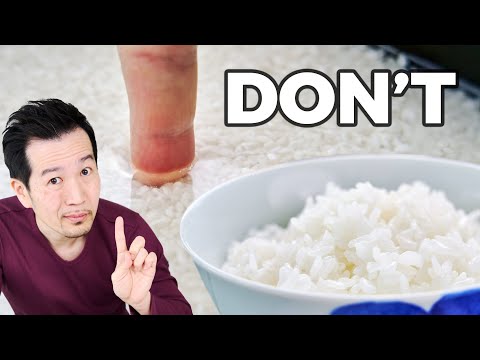
Units
Ingredients
- 300 grams Japanese short-grain rice (~1 ½ US cups)
- 1 ⅔ cup water (394 milliliters)
Instructions
- Put the 300 grams Japanese short-grain rice in a sieve and wash it in cold water until the water runs mostly clear.

- Drain the rice well and add it to a pot with high sides and a lid.

- Add the 1 ⅔ cup water and cover the pot with the lid. Let this soak for at least 30 minutes.

- When the rice is done soaking, turn the stove on to high heat and bring the water to a boil. Do not open the lid once you've turned the heat on.

- Once the water comes to a full boil, turn the heat down as low as possible and set a timer for 10 minutes.

- When the timer goes off, turn off the heat and let the rice steam for an additional 10 minutes.

- Once the rice is done steaming, open the lid and use a wet rice paddle or spatula to fluff the rice.


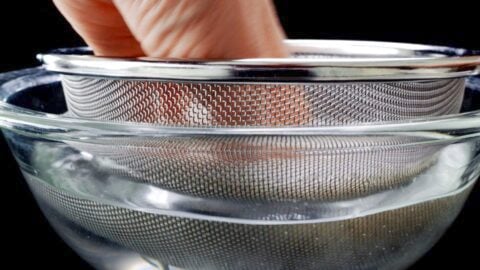
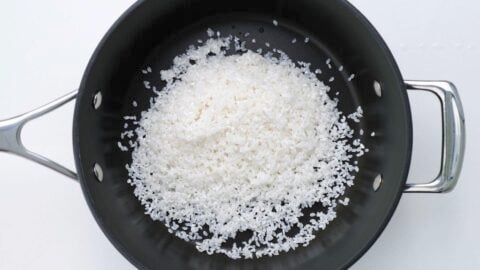
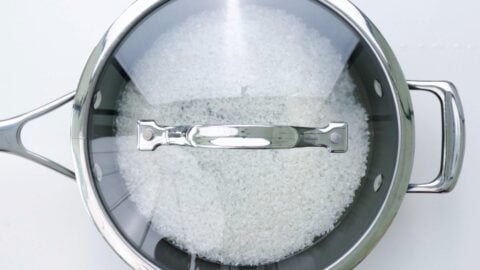
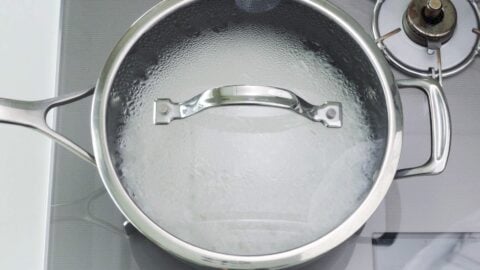


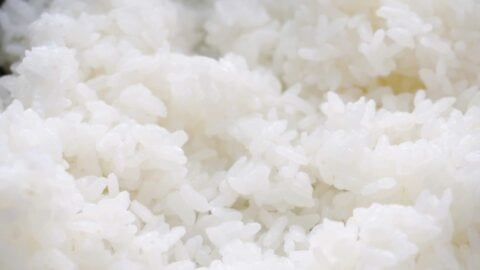
HV Mom says
I tripled this and it was perfection. Thanks so much!
Marc Matsumoto says
Happy to hear you enjoyed it! Thanks for letting me know!
Felix Lopez says
Absolutely perfect rice!
Marc Matsumoto says
Thanks Felix! Happy to hear this was helpful!
Claudia says
Any chance you can give a ratio version? Eg 1 cup rice to 1.25 cups water?
Marc Matsumoto says
Hi Claudia, the volumetric ratio is 1.5 rice to 1.7 water. The mass (weight) ratio would be 1.5 rice to 2 water.
Allen says
Thanks for this guide recipe, I now have perfect rice every time.
Marc Matsumoto says
You're welcome Allen! I'm glad this was helpful!
Al says
𝔾𝕠𝕠𝕕
SNL says
Great recipe! No chalky centre in rice, big tick. Rinsing rice is a pain/waste of my time, so I will try without soon and compare. Do read the recipe, I once soaked rice using boiling* water by accident and I came back with raw rice sitting in no water (adding water to cover made soggy rice with aforementioned chalky centre grr). Thank you for providing metric measurements despite being cups first recipe.
Marc Matsumoto says
Glad to hear this was helpful! As for washing, rice is washed because the milling process leads to a lot of starch buildup on the surface of the rice. This can make the rice gluey when cooked without washing (good well for risotto, but not so good for white rice). Some types of specially milled rice don't require washing. They're usually more expensive, but it's labelled as "無洗米".
Do says
Really delicious! I’m using this recipe from now on
Marc Matsumoto says
I'm happy to hear you enjoyed it! Thanks for dropping by to let me know!
Bambu says
So started making my rice this way when you first posted this recipe, a few months back. I don't soak the rice, but I do rinse it several times. I also don't ever measure the water to rice ratio, just eyeball it. My rice is perfect every single time. Thank you for this super easy method!
Marc Matsumoto says
Glad to hear this was helpful!
Kathy Stroup says
Very useful information! Now I understand all the steps involved in cooking rice and their importance. I had also wondered why some Japanese people visiting the US won't eat our rice. I never thought about it not being the same; rice is rice, isn't it? No. I will be more aware of the varieties of rice when I shop from now on. My family likes the CA Calrose rice just fine, but now I'm curious.
We used to always eat Thai Jasmine rice, but when the Pandemic hit, I had trouble finding it. Found a big bag of Calrose rice and figured we'd eat it. My family flipped for it! It's all they want to eat. I'm eager to see if that happens with the Japanese rice. Thanks for opening my eyes to the difference!
Marc Matsumoto says
I love the fragrance of Jasmine rice, and I also use basmati rice sometimes (mainly for Indian food), but for Japanese and Korean cuisine, short grain rice is tough to beat. It's is stickier, chewier, and sweeter compared to Calrose.
Kathy Stroup says
Just got a bag of California-grown Japanese rice. I will be trying it this weekend. It's Tamaki Gold, and it's grown in the Central Valley by a Japanese company: https://www.tamakimai.com/ I always prefer to use CA products, and my choice was to purchase mediocre imported rice, or spend a little more and get this.
I'm going to serve this with Chan Chan Yaki tomorrow. I also got a wonderful miso, Marukome Nama Koji. It smells complex and delightful!
Marc Matsumoto says
Hi Kathy, I think that's the brand my mom buys, so good call! Enjoy the Chan Chan Yaki! BTW that miso is great, we kinda drift between miso from Marukome and Hikari miso (depending on what's on sale at the supermarket 🤣) but I remember that as being a good one!
Kathy Stroup says
The notification worked! Nice to know that the rice is Mom approved!😁 We had Butadon with it tonight and it was wonderful. I don't usually eat dinner, but when that glaze went on the meat, I couldn't resist. The rice was so delicate compared to Calrose. It's like comparing a ballerina to a linebacker. I was just watching your California Roll video in preparation for making sushi with it. I feel like I'm finally getting to the heart of Japanese Cuisine. Since I'm not re-creating experiences of foods I've eaten, I can be a bit dense about it, but with your patient tutelage I'm getting there. It's astonishing to eat something I've prepared that tastes like it came from a restaurant.
Marc Matsumoto says
Yay! This is so nice to hear Kathy, this is why I do what I do😄
Kathy Stroup says
My husband's hooked on that Tamaki Gold rice! He's had it 3 days in a row, and it's packed in his lunch for tomorrow. I never thought he would be the one to flip over it!
Sarah says
Absolutely excellent!
Marc Matsumoto says
Thank you!
Kasper says
Followed the recipe exactly, got watery uncooked rice 👎🏼
Marc Matsumoto says
Hi Kasper I'm sorry to hear it didn't work out for you. I'm happy to help you troubleshoot but you're going to have to give me a little more to go off of here. Did you use the weight measurements? Did you us US cups (they're different from metric cups). Do you live in an area that's high altitude? What kind of rice did you use?
DJ says
Outstanding and educational overview as usual, Marc! We have several toddlers at home so I'm a tad paranoid about boiling water for another couple of years. I discovered a pretty amazing plastic microwave rice cooker from New Zealand's Sistema. I use your same washing/soaking instructions, and have found that 275g of Japonica (and even works with Basmati for Indian dishes) plus 450ml of room temperature is a great proportion. I cook for 9 minutes in a 900 watt microwave, and then let the rice rest for 10 minutes before fluffing. This method is so safe with kids or if you just find yourself running in too many directions at mealtime (especially breakfast)--or no space for a big rice cooker on the counter. It very surprisingly gives my $750 Zojirushi a run for the money (at about 3% of the price). It's also a nice option if you are traveling and have access to a microwave. You can put the rice and other foodstuffs (or socks?) inside the Sistema container so there's no wasted space. Thanks again for the great back to basics rice seminar!
Marc Matsumoto says
Thanks DJ, and thank you for sharing your microwave method. I've never tried making rice in the microwave oven, but I know there are rice cooking containers sold here in japan specifically designed for that purpose and I've heard it's convenient.